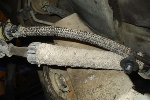DChaput
New Member
- Joined
- September 20, 2009
- Messages
- 4
- Reaction score
- 0
- City, State
- Auburn, AL
- Year, Model & Trim Level
- '00 Limited 4.0L SOHC
I own a 2000 Explorer, V-6 SOHC. In what's best described as ridiculous stupidity, I ran water only, no antifreeze, in the coolant system. Somewhat predictably, it froze. The car's overheating badly now - enough so that she's parked until I find and fix what broke in the freeze.
I know the upper radiator hose is split, so that's one thing I need to fix. I've looked at the block and the radiator and I can't see any freeze plugs pushed out, but I'm not sure where the plugs are, so I'm not sure they aren't out. I also know I need to drain and flush the system to get out the rust and crap that's accumulated from me running just water in there. But I hate to do that before I figure out what all needs to be fixed; I don't want to have to drain it more than once.
If any of ya'll can help me, I need to know where the freeze plugs are, and what else I need to check. What's most likely to have broken in the freeze?
Thanks!
I know the upper radiator hose is split, so that's one thing I need to fix. I've looked at the block and the radiator and I can't see any freeze plugs pushed out, but I'm not sure where the plugs are, so I'm not sure they aren't out. I also know I need to drain and flush the system to get out the rust and crap that's accumulated from me running just water in there. But I hate to do that before I figure out what all needs to be fixed; I don't want to have to drain it more than once.
If any of ya'll can help me, I need to know where the freeze plugs are, and what else I need to check. What's most likely to have broken in the freeze?
Thanks!










